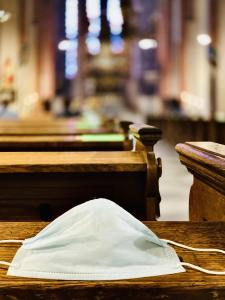It’s been a long year. Literally. Historians divide eras by cultural moments rather than strict dates. So future historians will likely consider us to still be living in “the long 2020,” at least until we reach herd immunity through mass vaccinations, and coronavirus restrictions are lifted.
Historians will write not only about COVID-19, but also about our era’s racial tensions and political polarization. We have all been experiencing multifaceted trauma for over a year.
And let’s not forget those of us who live in Texas. Truly good historians will include our extraordinary winter storm. So in addition to the rest of the long 2020, I spent nearly two weeks last month trying to keep myself and my parents alive in the face of sub-zero temperatures, impassible roads, and—in my parents’ case—no electricity and no running water. I repeat, while the roads were impassible.
As an American historian, I have studied and taught about all manner of leaders, good and bad. But living in a time of constant crisis has led me to reflect more deeply on what good leadership means.
It has also helped me appreciate how much I am dependent on good leaders. Like many professors, I hold leadership positions and have leadership tendencies. After all, we all run our own classrooms! At times I have a drive to be in charge. But crisis has a way of making us aware of our own limitations. To flourish—or even tolerably survive—in my own roles, whether leadership or not, I have to live under good leaders who carry part of the weight of life for me. Otherwise, I collapse under it.
I have also come to appreciate how much I am dependent on good leadership at multiple levels: my employer (a Christian university), the local church, local government, state government, and national government. Each has a different role to play in creating the conditions for individuals and the community to persevere under crisis and ultimately thrive.
So what does it look like for leaders to carry that weight well? Here I will focus on local non-government institutions (the university and the local church) where I have been able to make the most concrete observations. But I have had plenty of thoughts about local, state, and national governments that I may return to later!

THE UNIVERSITY
Baylor’s administration has, overall, been an excellent model of leadership through crisis this past year. (I’m tenured, so if it were not so, I would tell you!) Baylor has a vision that a distinctly Christian research university is an institution that the American community needs. Based on this overarching vision of Baylor’s mission, leaders chose to re-open in person for at least two reasons. First, they realized that the university needed to open in person to sustain itself financially for the long run. Also, the highest quality education is offered in person. The value of the institution’s mission therefore made re-opening worth the risk.
BUT, Baylor’s leaders did not conclude that the value of these priorities let it off the hook from its responsibilities to the health and well-being of its own community and the surrounding community of Waco. Consequently, they did every conceivable thing to make re-opening as safe as possible (masking, distancing, HVAC upgrades, required weekly COVID testing and subsequent contact tracing and quarantines)—and still gave all students the option to take a full schedule online and faculty with underlying conditions the option to teach fully online.
In other words, the university found a way forward that prioritized weighty things of long-term value, at some risk, while doing everything possible to mitigate that risk. Attending to the latter, combined with offering a range of options for different comfort levels, made it possible for all members of the community to participate in its educational project to a reasonable degree. Is education somewhat better when we can both meet in person and see each other’s faces in the classroom? Absolutely—but not enough more so to merit jeopardizing lives in the long run. Here leadership consisted in knowing the difference between reasonable risks for great good and unreasonable risks for lesser goods, even if some members of the community may have wanted more or fewer restrictions.
Baylor also took seriously the national reckoning on racial injustice and convened a commission including representatives from all constituencies (students, alumni, faculty, staff, regents) to investigate how Baylor’s history with slavery and racial injustice is represented on campus. It held several forums for the community to talk about the process and then released a report of the findings and recommendations. True leadership leads; it doesn’t neglect a controversial topic to keep the peace. But it does realize that everyone has had different experiences and brings different concerns to the table and takes the time to meet different constituents where they are to secure buy-in for the larger vision.
Overall, Baylor’s leadership made decisions not everyone would agree with, but in keeping with the clear values of the institution, and communicated clearly and frequently on the nature and rationale of those decisions. Indeed one of the few times Baylor’s leadership added rather than removed weight from my shoulders this past year was during the storm when it waited until the end of each day to tell us whether we needed to prepare for class the next day. (We were out for multiple days in a row owing to widespread power loss.) Their intention was to miss as few instruction days as possible, but when faculty were expending most of our energy trying to keep ourselves and our families alive, this probably did not judge the relative goods well. But the exception proves the rule: clear, timely, and frequent communication and explanation is one of the ways leaders lift burdens from others.
THE LOCAL CHURCH
Wow, this one was mixed. This past year I have been both greatly blessed and greatly distressed by the range of responses by the local church. This spread makes this category perhaps the most fruitful for reflections on leadership.
I started the year in a large church and ended it in a smaller one, both evangelical. In large part this change was simply the result of a long-simmering realization that I needed a smaller, more liturgical church for spiritual nourishment and growth at this point in my life. But what made the switch urgent was that I fell through the cracks of the large church’s response to the pandemic.

I retain great respect for the large church. After all, I belonged there for nearly a decade. What I most admire about it is that it successfully fuses clear preaching and teaching on the need for individual conversion with concrete service to the surrounding community and the world. Loving God and loving neighbor. And it lived this out: during the lockdown last March and April, the church coordinated an extraordinary weekly supply drive (toilet paper, cleaner, food, etc.) for economically disadvantaged members of the community. A year later, this strength was still apparent: during Texas’s storm it opened its doors to provide both food and heat for community members without electricity.
The problem started when the church re-opened in the early summer. There was scientific consensus by that time that the coronavirus not only spread within six feet, but also built up in indoor air over time, especially during loud talking or singing. Unfortunately, mask-wearing had also become politicized by that time, with a hefty subculture within the Republican party making masklessness a point of cultural pride. And that subculture was very much represented within evangelical churches. (Context: very Republican Texas nevertheless became a mask-order state in late June when we started making international news for our spike in cases, but churches were exempted from any restrictions whatsoever.)
Much like the case with Baylor’s educational goods, I agree that there are goods to in-person worship that are worth the risk. Unfortunately, unlike Baylor, the church did not do all it could to mitigate that risk. The result was that more members of the community got left out. With the briefest of statements asking the church not to let masking become divisive and move its focus off the gospel and service, church leaders split the difference: the church required masking only until members reached their distanced seats for the services, all of which continued to be held indoors, and it continued high-quality streaming for those who preferred to attend remotely.
To be fair, this relatively laissez-faire approach may have been influenced by the fact that church leadership was simultaneously attempting to raise awareness of racial justice issues. They may have feared taking on too many live-wire topics at once; the pastor marched in our local peaceful summer demonstrations calling attention to the injustices experienced by the Black community.
In a sense, the church’s approach to the pandemic worked for most members (although I would argue it jeopardized the health of the surrounding community, whom the church otherwise excelled at serving): those comfortable with distancing without masks attended in person, while those who were not attended remotely. But neither option worked for someone like me. Cautious by both personality and conviction, I could not attend in person in good conscience. But by that time I had been living in isolation for a long time and desperately needed to worship with others.
Here I should note that 41-year-old women with PhDs who live alone are not the average demographic of any church, and hence likely not on the mind of the elder board. But that is, perhaps, what highlights the problem. It was not actually possible to provide for all members of the community by letting everyone mostly do what they wanted—unless you ignored some members of the community. Sometimes to provide for everyone you have to ask something of the community (in this case masking, since masks, as we all know by now, protect others more than yourself).

After the initial brief announcement, the church never gave a rationale for its approach, presumably not to be divisive. It also never offered concrete pastoral resources for coping with the truly unprecedented stresses brought on by the pandemic, intending perhaps to keep its focus on long-term goods. Maybe most of its members, living in the community of families, were honestly OK. But as an intellectual who lived alone, I sunk under the weight of being both unpastored in terms of a vision for how to live well in the moment and literally shut out of the church for lack of a safe place to worship. (Several months after I had switched churches, the original church moved to offering one masked service for members like me.)
During this time I sought out resources from other evangelical churches nationwide and am pleased to report that some did an excellent job of laying out the competing goods at play, acknowledging different perspectives, and casting a clear vision. I realized I could belong to a church where I agreed with the policy even if it was not articulated well, or sometimes where I disagreed with the policy but the rationale was articulated well and in such a way as to acknowledge other priorities. I could not belong to one that did neither.
Contrast this laissez-faire approach with the smaller church’s response to the pandemic. I knew what was going on there because I had taken to reading the church’s weekly pastoral letters as part of living the liturgical calendar in my own life. I realized how much I appreciated weekly pastoral letters. In addition to marking the liturgical calendar, they gave concrete spiritual advice for navigating the difficulty of the pandemic. I had the spiritual knowledge and training to figure this out for myself, but I was all out of emotional resources. Hence my realization of how much I needed robust spiritual leadership for my own thriving, even though in theory I could have done that work myself.
Most importantly, the rector instituted a mask order for all church services AND the church began offering one of the services outdoors (an idea pioneered by some church members and subsequently embraced by the rector and vestry). Masked, distanced, and outdoors was safe enough even for this germaphobe to relax and worship more freely! The rector explained the rationale clearly and repeatedly: as part of a liturgical tradition, the church placed great value on the formative nature of in-person worship and wanted to ensure as many members of the community as possible felt comfortable attending that worship. The church also continued to stream services for very high-risk members or others still uncomfortable with even those precautions. Although some members grumbled, the church held the line with masks on the grounds of Romans 14: those who feel they have more freedom should limit their freedom when necessary to show love to others. The church did so even though by personality the rector was not particularly concerned about catching COVID himself.
As someone who is in many ways strong and privileged, it has been a good lesson for me in my own leadership roles to have been the weak one that leaders protected by asking things of my community. And from observing both churches and the university, I have learned that the rationale for that ask needs to be laid out clearly and frequently.
The conclusion of the matter: Laissez-faire, hands-off governance, even when intended to preserve unity in the service of greater goods, ultimately sacrifices the weak to the strong. Good leadership means being willing to cast a clear vision that may ask more of the strong, and being strong enough to take the push-back to defend the weak. In the words of my rector to those who considered masking a capitulation to fear, “It is better to love courageously than to love courage.”

















